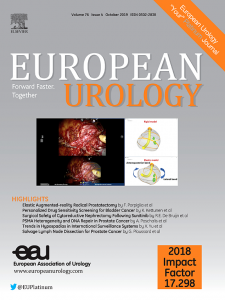European Association of Urology Guidelines on Upper Urinary Tract Urothelial Carcinoma: Summary of the 2025 Update
IF 25.3
1区 医学
Q1 UROLOGY & NEPHROLOGY
引用次数: 0
Abstract
Background and objective
We present a summary of the 2025 update for the European Association of Urology (EAU) guidelines for upper urinary tract urothelial carcinoma (UTUC). The aim is to provide practical recommendations on the clinical management of UTUC with a focus on diagnosis, treatment, and follow-up.Methods
For the 2025 guidelines on UTUC, new and relevant evidence was identified, collated, and appraised via a structured assessment of the literature. Databases searched included Medline, EMBASE, and the Cochrane Libraries. Recommendations within the guidelines were developed by the panel to prioritise clinically important care decisions. The strength of each recommendation was determined according to a balance between desirable and undesirable consequences of alternative management strategies, the quality of the evidence (including the certainty of estimates), and the nature and variability of patient values and preferences.Key findings and limitations
Key recommendations emphasise the importance of thorough diagnosis, treatment, and follow-up for patients with UTUC. The guidelines stress the importance of appropriate treatment taking into account patient values and preferences. Key updates in the 2025 UTUC guidelines include: significant changes to the recommendations for UTUC diagnosis; complete revision of the sections addressing risk stratification, ureteroscopy, and the surgical approach for radical nephroureterectomy; addition of four new recommendations, two related to kidney-sparing management of localised low-risk UTUC and a further two related to management of high-risk nonmetastatic UTUC; a review and adaptation of recommendation for UTUC follow-up; and addition of a new section addressing quality indicators for UTUC management.Conclusions and clinical implications
This overview of the 2025 EAU guidelines on UTUC offers valuable insights into risk factors, diagnosis, classification, treatment, and follow-up for UTUC. The guidelines contain information on the management of individual patients according to the current best evidence and are designed for effective integration in clinical practice.求助全文
约1分钟内获得全文
求助全文
来源期刊

European urology
医学-泌尿学与肾脏学
CiteScore
43.00
自引率
2.60%
发文量
1753
审稿时长
23 days
期刊介绍:
European Urology is a peer-reviewed journal that publishes original articles and reviews on a broad spectrum of urological issues. Covering topics such as oncology, impotence, infertility, pediatrics, lithiasis and endourology, the journal also highlights recent advances in techniques, instrumentation, surgery, and pediatric urology. This comprehensive approach provides readers with an in-depth guide to international developments in urology.
 求助内容:
求助内容: 应助结果提醒方式:
应助结果提醒方式:


